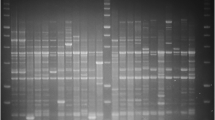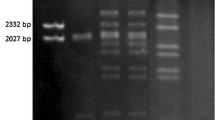Abstract
Ten wild-type strains ofCorynebacterium fascians, which differed in degree of virulence as measured by ability to cause hyperplasias (multiple stems; fasciation) in pea seedlings, were examined for the presence of plasmids. Four strains were highly virulent, three were avirulent, and three were intermediate in virulence. All of these wild-type strains harbored one plasmid each of approximately 78 megadaltons, as estimated from electrophoretic mobilities in agarose gels capable of resolving reference plasmids ranging from 8.8 to 350 Mdal. Restriction endonuclease (EcoRI andBamHI) cleavage patterns of these nominally 78-MdalC. fascians plasmids suggest that the plasmids are not uniformly of high homology, although similar or identical in electrophoretic mobility in the system used. The relationship of the 78-Mdal plasmids to the phytopathogenicity ofC. fascians remains uncertain, although the restriction endonuclease cleavage patterns do indicate that the plasmids from the highly virulent strains are more closely related to the plasmids from the strains intermediate in virulence than they are to the plasmids from the avirulent strains.
Similar content being viewed by others
Literature Cited
Charayil, J. D., Lipsett, M. N. 1977. Zeatin ribonucleosides in the transfer ribonucleic acid ofRhizobium leguminosarum, Agrobacterium tumefaciens, Corynebacterium fascians andErwinia amylovora. Journal of Bacteriology131:741–744.
Chassy, B. M. 1976. A gentle method for the lysis of oral streptococci. Biochemical and Biophysical Research Communications68:603–608.
Chatterjee, A. K., Buss, R. F., Starr, M. P. 1977. Unusual susceptibility ofErwinia amylovora to antibacterial agents in relation to the barrier function of its cell envelope. Antimicrobial Agents and Chemotherapy11:897–905.
Comai, L., Kosuge, T. 1980. Involvement of plasmid deoxyribonucleic acid in indoleacetic acid synthesis inPseudomonas savastanoi. Journal of Bacteriology143:950–957.
Currier, T. C., Nester, E. W. 1976. Evidence for diverse types of large plasmids in tumor-inducing strains ofAgrobacterium. Journal of Bacteriology126:157–165.
Currier, T. C., Nester, E. W. 1976. Isolation of covalently closed circular DNA of high molecular weight from bacteria. Analytical Biochemistry76:431–441.
Dekhuijzen, H. M. 1976. Endogenous cytokinins in healthy and diseased plants, pp. 526–559. In: Heitefuss, R., Williams, P. H. (eds.), Physiological plant pathology. Berlin, Heidelberg, New York: Springer-Verlag.
Gantotti, B. V., Beer, S. V. 1982. Plasmid-borne determinants of pigmentation and thiamine prototrophy inErwinia herbicola. Journal of Bacteriology151:1627–1629.
Gross, D. C., Vidaver, A. K., Keralis, M. B. 1979. Indigenous plasmids from phytopathogenicCorynebacterium species. Journal of General Microbiology115:479–489
Kado, C. I., Liu, S.-T. 1981. Rapid procedure for detection and isolation of large and small plasmids. Journal of Bacteriology145:1365–1373.
Lacey, M. S. 1955. The cytology and relationships ofCorynebacterium fascians. Transactions of the British Mycological Society38:49–58.
Murai, N., Skoog, F., Doyle, M. E., Hanson, R. S. 1980. Relationships between cytokinin production, presence of plasmids, and fasciation caused by strains ofCorynebacterium fascians. Proceedings of the National Academy of Sciences of the United States of America77:619–623.
Nester, E. W., Kosuge, T. 1981. Plasmids specifying plant hyperplasias. Annual Review of Microbiology35:531–565.
Oduro, K. A., Munnecke, D. E. 1975. Persistence of pea cotyledons induced byCorynebacterium fascians. Phytopathology65:1114–1116.
Starr, M. P., Mandel, M., Murata, N. 1975. The phytopathogenic coryneform bacteria in the light of DNA base composition and DNA-DNA segmental homology. Journal of General and Applied Microbiology21:13–26.
Tilford, T. E. 1936. Fasciation of sweet peas caused byPhytomonas fascians n. sp. Journal of Agricultural Research53:383–394.
Van Larabeke, N., Engler, G., Holsters, M., Van den Elsacker, S., Zaenen, I., Schilperoort, R. A., Schell, J. 1974. Large plasmid inAgrobacterium tumefaciens essential for crown gall-inducing ability. Nature252:169–170.
Vidaver, A. K., Starr, M. P. 1981. Phytopathogenic coryneform and related bacteria, pp. 1879–1887. In: Starr, M. P., Stolp, H., Trüper, H. G., Balows, A., Schlegel, H. G. (eds.), The prokaryotes: A handbook on habitats, isolation, and identification of bacteria. Berlin, Heidelberg, New York: Springer-Verlag.
Watson, B., Currier, T. C., Gordon, M. P., Chilton, M.-D., Nester, E. W. 1975. Plasmid required for virulence ofAgrobacterium tumefaciens. Journal of Bacteriology123:255–264.
White, F. F., Nester, E. W. 1980. Hairy root: Plasmid encodes virulence traits inAgrobacterium rhizogenes. Journal of Bacteriology141:1134–1141.
Author information
Authors and Affiliations
Rights and permissions
About this article
Cite this article
Lawson, E.N., Gantotti, B.V. & Starr, M.P. A 78-megadalton plasmid occurs in avirulent strains as well as virulent strains ofCorynebacterium fascians . Current Microbiology 7, 327–332 (1982). https://doi.org/10.1007/BF01572598
Issue Date:
DOI: https://doi.org/10.1007/BF01572598




